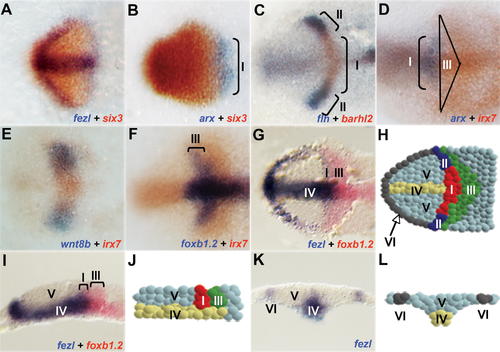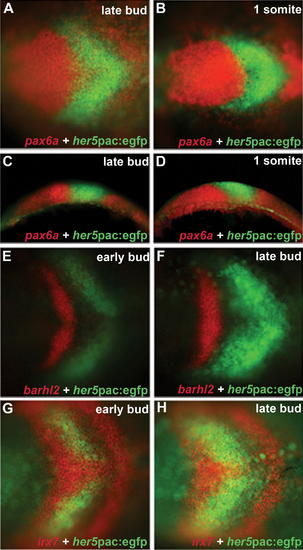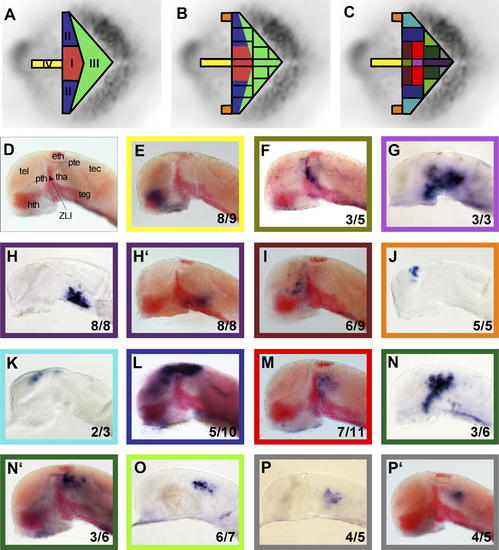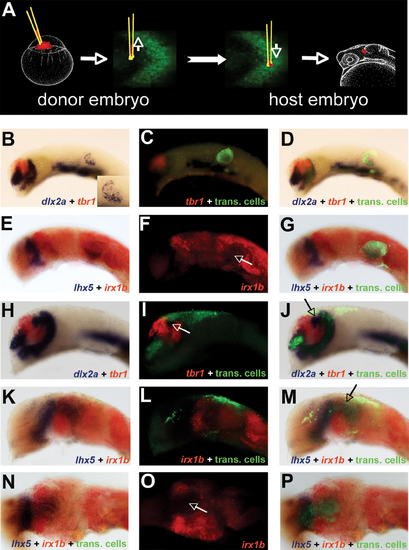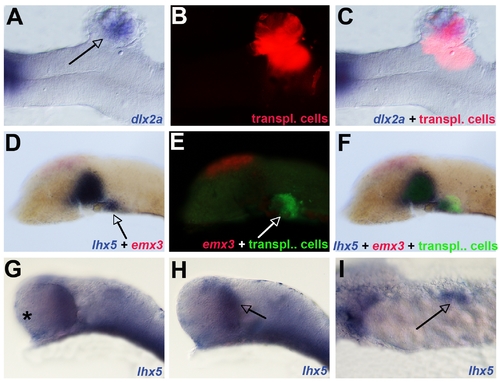- Title
-
The prethalamus is established during gastrulation and influences diencephalic regionalization
- Authors
- Staudt, N., and Houart, C.
- Source
- Full text @ PLoS Biol.
|
Expression Profile of the Rostral Neural Plate (A?G) Rostral neural plate, anterior to the left. Embryos at bud stage (A?D, F, G , I, and K) or 100% epiboly (E) are shown. (A) six3 (red), fezl (blue). (B) six3 (red), arx (blue). (C) barhl2 (red), flh (blue). (D) irx7 (red), arx (blue). (E) irx7 (red), wnt8b (blue). (F) irx7 (red), foxb1.2 (blue). (G) foxb1.2 (red), fezl (blue). (H) Scheme of the different expression domains inside the diencephalon anlage shown in (A?G). (I) Sagittal section, anterior left, foxb1.2 (red), fezl (blue). (J) Scheme of (I). (K) Transverse section, fezl (blue). (L) Scheme of (K). The different domains are the presumptive anteromedial (I), anterolateral (II), and posterior (III) diencephalon, hypothalamus (IV), and eye field (V). |
|
GFP Transgenic Lines Provide Good Landmarks in the Neural Plate (A?D) pax6a (red) and her5pac:egfp (green) are expressed in adjacent neural plate territories at bud stage (A and C) and 1-somite stage (B and D); The same embryos are shown in dorsal (A and B) and lateral views (C and D), rostral to the left. (C and D) show dynamic changes in the neural plate positioning the rostral midbrain dorsal to the caudal diencephalon; (E and F) Dorsal views, rostral to the left of neural plates showing barhl2 (red) and her5pac:egfp (green) expression revealing a shape change of the rostral diencephalon from a mild V-shape (E) at early bud stage to a straight line (F) at late bud stage; (G and H) Dorsal views, rostral to the left of neural plates showing irx7 (red) + her5pac:egfp (green) expression, visualizing the domain of the caudal diencephalon anterior to the midbrain at early bud stage (G) and late bud stage (H). EXPRESSION / LABELING:
|
|
Schematic of the Uncaging Procedure (A) Caged fluorescein is injected into one-cell stage her5pac:egfp embryos. Injected embryos are kept in the dark until the fluorescein is uncaged in 6?10 cells of the diencephalic neural plate at bud stage using a laser beam. After further light-protected incubation, the embryos are fixed at prim5 stage, and the uncaged form of the fluorescein is detected via antibody staining. (B) Transverse section of a neural plate after the uncaging experiment, cells of the whole z-axis are labelled. (C) Result of labelling cells via uncaging in domain I, which correlates mostly with the expression pattern of barhl2 at bud stage. (D) At prim5, labelled areas in the diencephalon resemble the endogenous expression pattern of barhl2. |
|
Fate of Caudal Forebrain Precursors (A) Schematic showing the four different diencephalic expression domains identified in Figure 1. (B) Arbitrary subdivision grid of the caudal forebrain shown on top of the expression domains plus an additional telencephalic subdomain (orange). (C) Colour code used for the final 12 domains investigated. Embryos in (D, E, F, H′, I, L, M, N′, and P′) show the expression of shh and otx5 in red. (D) Different areas of the rostral brain are labelled on an embryo showing expression of shh (in the ZLI) and otx5 (in the pineal gland) in red. (E) Cells of the bright yellow midline area are found in the hypothalamus. (F) Cells inside the lime midline domain populate the ventral ZLI. (G) The light violet area spans the posterior hypothalamus, the basal ZLI, posterior tuberculum, and some of the anterior tegmentum. (H and H′) Cells of the caudal-most midline domain of the forebrain are detected in the anterior tegmentum. (I) Cells labelled in the dark red domain of the neural plate contribute to the prethalamus. (J) Precursors of the orange area will populate the posterior dorsal-most telencephalon. (K) The light blue includes precursors of the dorsal telencephalon and the epithalamus. (L) The dark blue area marks cells of the dorsal telencephalon, epithalamus, and dorsal pretectum. (M) In the light red area, we found precursors of the thalamus. (N?P) (N and N′) Cells of the dark green domain can be found in the dorsal thalamus and, in some cases, in a stream of cells running down to the posterior hypothalamus (N2). Precursors of the light green area (O) populate parts of the pretectum and the tectum whereas cells of the grey area (P and P′) were detected in cells close to the midbrain. Because of the nature of the experiment (negative landmarks and fast developing embryos), we were not always reproducibly labelling the same cells in each experiment. Therefore, one can find, for each experiment, the number of embryos we labelled per experiment and how many of these result in the shown cell labelling. (For example 8/9 means eight out of nine embryos show the same labelling in the area depicted in the picture). eth, epithalamus + pineal gland; hth, hypothalamus; pte, pretectum; pth, prethalamus; tec, tectum; teg, tegmentum; tel, telencephalon; tha, thalamus. EXPRESSION / LABELING:
|
|
Cell Movement in the Neural Plate (A and B) Schematic overview of the results obtained by the fate-mapping experiments. Colours at prim5 stage correspond to the territories labelled at bud stage. (C?E) Time-lapse analysis of nuclei (red) movement in the neural plate in her5pac:egfp (green): 3D rendering of a 200-μm z-series done at (C) bud stage and (D) 5-somite stage. (E) Schematic overview of the trajectories of individual nuclei over the recorded time (time-lapse movie can be seen in Video S1), with labelled nuclei in white. Wavy lines and dark to light colours of the lines represent the timeline of nuclei movement. Some lines are shorter because nuclei moved out of or into the observed area over the recorded time. We observed three types of movement: the basal cells move anteriorly (green arrow), posterior alar cells move towards the midline and then anteriorly (yellow arrow), and anterior alar cells move diagonally towards the midline (red arrow). (F?L) Transplantation of basal cells: (F) animal pole view in which labelled cells (green) are transplanted on top of the shield; (G) schematic lateral view of shield stage embryo in which transplanted cells are going to move towards the animal pole during gastrulation; (H) schematic lateral view of bud stage embryo in which transplanted cells are spread along the midline of the embryo; and (I) shhGFP is shown in green, transplanted cells in red, at 22 hpf in a live embryo. (J?L) shh is shown in red, transplanted cells in green; at 30 hpf, basally derived cells form a large proportion of the brain, showing that just the tip of the ZLI is formed by alar plate cells (white arrow), the basal ZLI is composed of basal cells (white double arrow), and the ventral part of the developing thalamus is built by basal cells (yellow arrow). The yellow line in (K) indicates the border between alar and basal plate; the arrowhead in (K) points to a single basal cell moving alar. |
|
Ablation of Prethalamic Precursors (A?D) barhl2 (red) and her5pac:egfp (green) are shown in (A) wild-type (wt) and (B?D) prethalamus-ablated (abl) embryos 2 h after surgery. (E?G) arx expression at the 12-somite stage and (H?J) prim5 stage in ablated embryos are shown, representing the different ablation types. (K and L) tbr1 is shown in red, and dlx2a in blue; in comparison to the wt (K), the prethalamic expression of dlx2a is reduced in ablated embryos (arrow in [L]). (M and N) foxb1.2 expression at prim 5 shows that mid-diencephalic domains in ablated embryos are not impaired although the expression appears unorganized in the thalamic domain (arrow in [N]). EXPRESSION / LABELING:
|
|
Transplantation of Prethalamic Precursors (A) Schematic overview of the transplantation experiment putting prethalamic precursors in ectopic regions of the neural plate. (B?D and H?J) shows dlx2a (blue), tbr1 (red), and transplanted cells in green; (E?G and K?P) shows lhx5 (blue), irx1b (red), and transplanted cells in green. (B?G) Transplanted cells located in the hindbrain show ectopic expression of the prethalamus markers dlx2a (B?D) or lhx5 (E?G); no expression of the telencephalon marker tbr1 (see inset in [B]) could be found in the clone. Cells do not exhibit expression of irx1b (arrow in [F]) in the transplanted cells. (H?P) After transplantation into the forebrain, ectopic cell?non-autonomous expression of dlx2a (arrow in [J]) could be seen (probably resulting in the split of the telencephalon, arrow in [I]) as well as of lhx5 in the thalamus (arrow in [M]). Cells did not switch on the expression of thalamic irx1b (arrow in [O]) in the thalamus. |
|
Transplantation of Prethalamic Precursors in Ectopic Environment (A?C) At 22 hpf (dorsal view, rostral to the left), ectopic expression of dlx2a inside part of the clone cells expressing the prethalamic marker form an ectopic epithelial structure (arrow in [A]). (D?F) At the 10-somite stage (lateral view, rostral to the left), ectopic expression of the prethalamic marker lhx5 could be found in a subset of the transplanted cells, but no ectopic expression of the telencephalon marker emx3 in that basally located clone was found. (G?I) At 24 h, cyclopamine-treated from bud to 24 h, successful treatment with cyclopamine leads to the development of big and almost fused eyes ([G], asterisk); no hypothalamus is detectable. (H) Endogenous expression of lhx5 (arrow) is still detectable in the prethalamus of cyclopamine-treated embryos. (I) Dorsal view, rostral to the left: ectopic expression of lhx5 by the transplantation of anterior diencephalic cells after cyclopamine treatment (arrow) is shown. |

